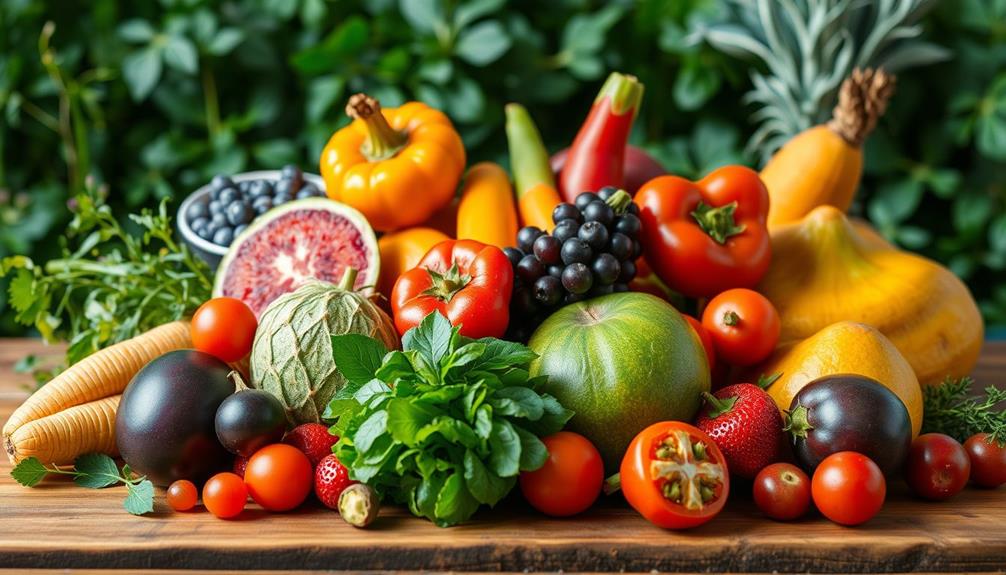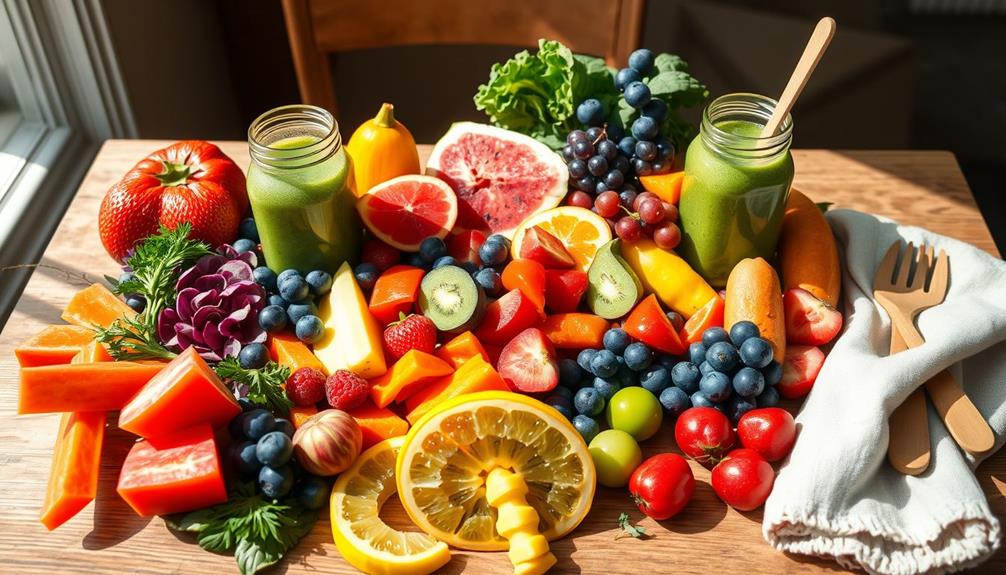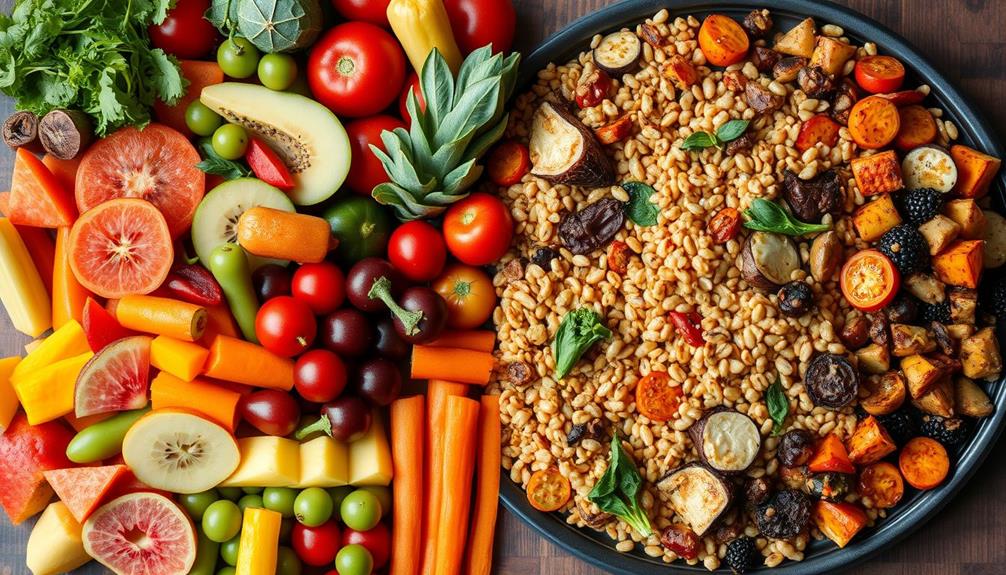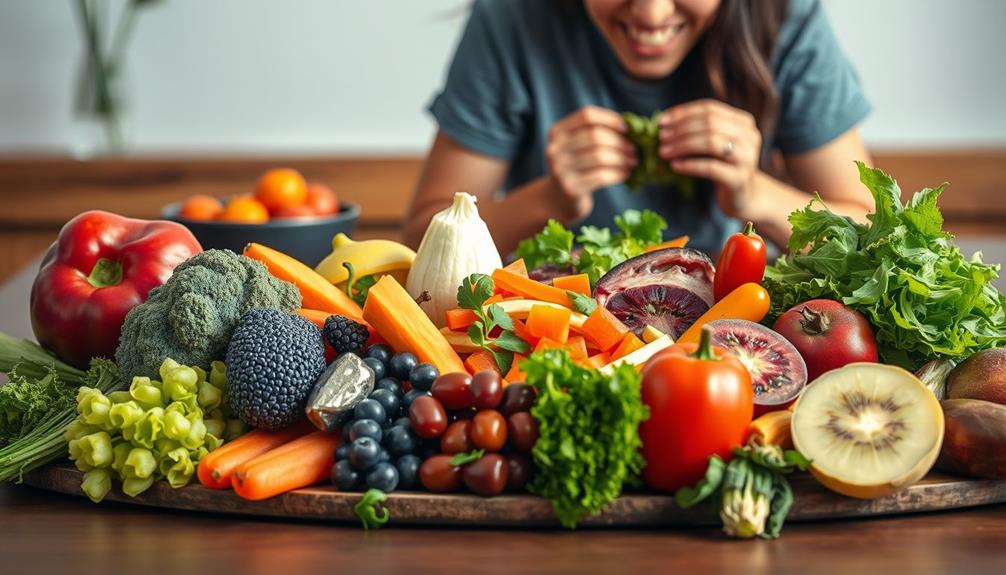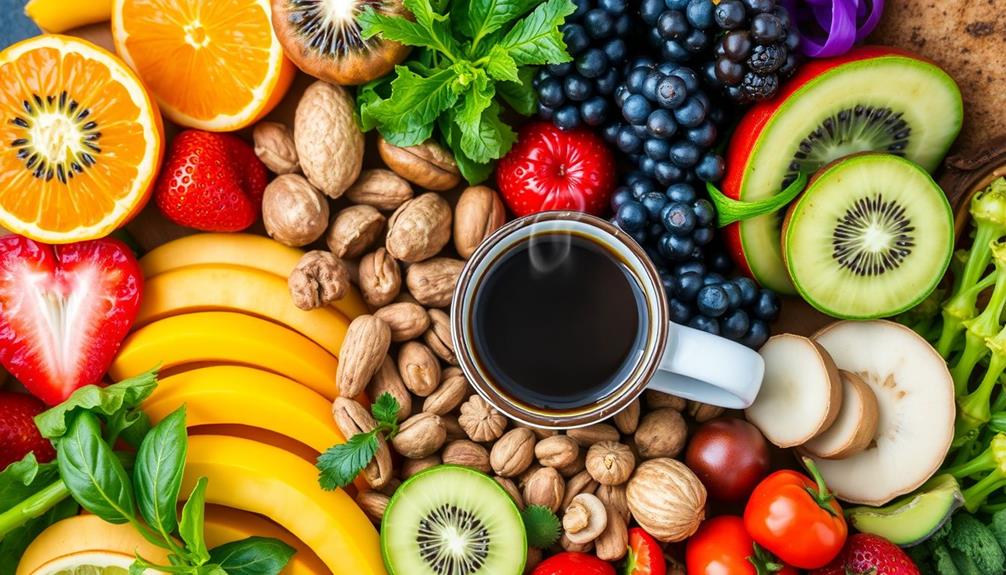Raw food can be harder to digest for many people because of its high fiber content and tough cell walls. Raw vegetables, in particular, often contain cellulose, which you can't easily break down. This can lead to discomfort and bloating. In contrast, cooking makes food easier to digest by breaking down these structures and enhancing nutrient absorption. However, raw foods retain valuable enzymes and vitamins that cooking can diminish. Everyone's digestive system reacts differently, so finding the right balance between raw and cooked foods is key. There's more to explore about the best ways to enjoy both types of food. One way to find the right balance is to consider a raw food nutrient comparison with cooked food. By understanding the specific nutrients that are retained or lost during the cooking process, you can make more informed decisions about your diet. For example, while cooking can decrease the vitamin C content in vegetables, it can also make certain nutrients more available for absorption. It’s important to consider the pros and cons of both raw and cooked foods to maximize the benefits for your health.
Key Takeaways
- Raw foods, especially vegetables, contain high fiber that can complicate digestibility and lead to discomfort for some individuals.
- Cooking breaks down tough fibers in raw vegetables, improving nutrient absorption and overall digestibility.
- Raw meat may be easier to digest than raw vegetables due to lower fiber content, but carries health risks from pathogens.
- A diverse gut microbiome influences individual tolerance to raw foods, which can vary from person to person.
- Combining raw and cooked foods in a balanced diet optimizes nutrient intake and supports digestive health.
Overview of Raw and Cooked Foods
When considering the differences between raw and cooked foods, it's important to understand how each impacts your digestion and nutrient absorption. Raw foods generally retain higher levels of heat-sensitive vitamins and natural enzymes that aid in digestion. For example, juices made from raw ingredients, like celery juice, are known for their anti-inflammatory properties and can promote hydration.
However, when you look at raw versus cooked, cooked foods often improve digestibility by breaking down cell walls and fibers, making nutrients more accessible to your body. For instance, while raw vegetables contain cellulose that's tough for you to digest, cooking softens these fibers, allowing your body to absorb nutrients more effectively. Cooking also enhances nutrient bioavailability; nutrients like beta-carotene in carrots and lycopene in tomatoes become more accessible when cooked.
Yet, high-fiber raw diets might lead to discomfort or bloating for some individuals, as cooked foods typically have less fiber and easier structures to digest.
Another crucial aspect is gut health. Cooking eliminates harmful bacteria and pathogens, reducing the risk of foodborne illnesses often associated with improperly handled raw foods.
Digestibility of Raw Foods

When it comes to digesting raw foods, the type of food you choose plays a significant role.
Raw meat might be easier for you to digest compared to raw vegetables, mainly because it has less fiber.
Additionally, some individuals may find that consuming a variety of foods, including common types of cold medications, can influence digestive comfort.
On the other hand, the high fiber content in raw veggies can lead to discomfort for some, making it essential to know how your body reacts.
Raw Meat Digestibility
Raw meat digestibility often sparks debate among health enthusiasts and those exploring dietary choices.
While raw meat contains less fiber than raw vegetables, making it easier for some individuals to digest, the lack of cooking raises concerns. Cooking enhances digestibility by breaking down proteins, which helps with nutrient absorption.
However, raw meat may provide a more direct source of protein since digestive enzymes can process it efficiently. Additionally, incorporating certain essential oils, such as peppermint oil for digestive support, may aid in the overall digestive process.
Your experience with raw meat digestibility can vary greatly based on your gut microbiome and personal health. Some people report that they find raw meat easier to digest, but it's essential to be aware of potential health risks. Uncooked animal products can harbor pathogens that pose serious health threats.
Fiber in Vegetables
Eating raw foods can be a double-edged sword, especially when it comes to vegetables. Raw vegetables are packed with crucial nutrients, but their high fiber content, particularly cellulose, can complicate digestibility.
Proper diet for hamsters focuses on the balance of fresh and cooked options, which can be applicable to human diets as well. Since humans lack the enzyme cellulase, breaking down this tough fiber becomes a challenge. As a result, you might find that raw veggies hinder nutrient absorption, making it harder for your body to access vital vitamins and minerals.
In contrast, cooking vegetables softens their cell walls. This process improves digestibility and enhances nutrient absorption compared to raw foods. If you have a sensitive digestive system, consuming high-fiber raw vegetables might lead to discomfort, such as bloating, as your body struggles with the coarse fiber.
While raw vegetables are beneficial, especially in retaining heat-sensitive vitamins, it's crucial to balance your intake with cooked options. By doing so, you can enjoy the advantages of both forms while optimizing digestibility and nutrient absorption.
Benefits of Cooking

Cooking offers significant benefits by enhancing the bioavailability of nutrients in your food. When you apply heat, it breaks down tough fibers and reduces anti-nutrients, making it easier for your body to absorb essential vitamins and minerals.
Additionally, incorporating essential oils for skin conditions may improve your overall health while cooking.
Plus, cooking can boost the levels of certain antioxidants, improving your overall health.
Nutrient Bioavailability Improvements
Many people may not realize that cooking can greatly enhance nutrient bioavailability, making it easier for your body to absorb essential vitamins and minerals. For instance, cooking carrots increases beta-carotene availability, while tomatoes offer more lycopene when cooked.
Furthermore, certain cooking methods can even play a role in reducing cancer risks, as early detection through mammography guidelines is vital for breast cancer awareness. By breaking down plant cell walls, cooking improves the digestibility of starches and proteins, allowing you to extract more nutrients from your meals.
Cooked sweet potatoes provide more energy and nutrients compared to raw foods because cooking transforms hard-to-digest starches into more absorbable forms. In addition, certain cooking methods, like steaming and stir-frying, help preserve nutrients while enhancing their bioavailability.
In contrast, boiling can lead to significant nutrient losses, so it's important to choose your cooking methods wisely.
Furthermore, cooking legumes and grains reduces anti-nutrient content, such as phytic acid, which can impede mineral absorption. This reduction leads to improved overall nutrient intake and health benefits.
Digestive Aid Mechanisms
The process of cooking serves as a powerful digestive aid, transforming raw ingredients into more accessible forms. When you cook foods, it breaks down plant cell walls, making nutrients easier to digest and absorb. This is particularly important for raw fruits and vegetables, which may contain tough fibers that can challenge your digestive system.
Cooking increases the bioavailability of nutrients, enhancing your overall nutrient absorption. Additionally, much like the radiant joy found in Blue Skies and Lemonade, cooked foods can evoke a sense of comfort and satisfaction that contributes to a positive eating experience.
Moreover, heat from cooking deactivates anti-nutrients like phytic acid found in grains and legumes. By reducing these compounds, cooking improves nutrient absorption and minimizes digestive discomfort. Cooked foods also tend to have reduced fiber toughness, which makes them easier to chew and digest, especially fibrous vegetables.
Certain cooking methods, such as steaming and boiling, can further enhance the availability of beneficial antioxidants, like lycopene in tomatoes, which support digestive health.
Studies show that individuals generally absorb more energy and nutrients from cooked foods, as cooking transforms complex carbohydrates into easily digestible forms. Fundamentally, cooking not only makes food tastier but also greatly boosts its digestibility and nutrient benefits.
Nutritional Changes in Cooking

When you cook food, it undergoes significant nutritional changes that can enhance its digestibility and nutrient absorption. Cooking alters the physical structure of both cooked and raw foods, breaking down fibers and proteins, which ultimately improves digestibility.
Certain cooking methods, like steaming or stir-frying, help preserve more nutrients compared to boiling, which can cause a loss of water-soluble vitamins by 50-60%. Additionally, cooking with ingredients like butter can further enhance flavor and moisture, making dishes more enjoyable and palatable, as seen in butter in global cuisine.
Cooking increases the bioavailability of key nutrients. For example, beta-carotene in carrots and lycopene in tomatoes become more accessible to your body once cooked. On the other hand, some raw foods contain anti-nutrients that can hinder digestion and nutrient absorption. Cooking reduces these compounds, further enhancing overall digestibility.
Starchy foods also demonstrate improved digestibility when cooked. Cooked sweet potatoes, for instance, provide more energy and nutrients compared to their raw counterparts.
Safety Concerns With Raw Foods

When you're enjoying raw foods, it's important to be aware of the risks involved. Proper hygiene is essential, just as with body piercings, where piercing care and hygiene play an important role in preventing infections.
Common culprits like raw meat, fish, and certain vegetables can harbor harmful bacteria that lead to foodborne illnesses. To stay safe, you'll want to focus on proper preparation methods and be mindful of sourcing your ingredients.
Common Contaminated Raw Foods
Raw foods can pose substantial safety concerns due to the risk of contamination from harmful pathogens. Individuals with emotional dysregulation, such as those with Borderline Personality Disorder, may find themselves drawn to impulsive food choices, including raw foods, which can exacerbate their health risks.
Leafy greens like spinach and lettuce, as well as raw sprouts, are commonly linked to foodborne illness outbreaks caused by bacteria such as E. coli and Salmonella. Consuming raw meat, poultry, and fish also presents serious health risks, as these items can harbor dangerous bacteria and viruses. Proper cooking is vital to eliminate these pathogens and keep you safe.
Unpasteurized dairy products can contain harmful bacteria, including Listeria and Campylobacter, underscoring the significance of pasteurization for safety. Additionally, raw eggs carry the risk of Salmonella infection, which can lead to severe gastrointestinal illness, especially in vulnerable groups like the elderly or immunocompromised individuals.
To minimize these health risks, practicing safe food handling is essential. Always wash raw fruits and vegetables thoroughly and make sure proper refrigeration of perishable items.
Risks of Foodborne Illness
Foodborne illnesses present a considerable risk, particularly when consuming raw foods. You mightn't realize that raw meat and fish can harbor harmful bacteria like E. coli and Salmonella, which lead to severe gastrointestinal infections.
The CDC estimates that about 1 in 6 Americans experience foodborne illnesses each year, with raw animal products being a major contributor.
It's not just meats that pose a threat; even raw vegetables such as spinach, lettuce, and sprouts can be contaminated with pathogens. This highlights the essential need for food safety practices.
Cooking food at appropriate temperatures is fundamental for eliminating these harmful pathogens. For example, cooking ground beef to an internal temperature of 160°F (71°C) greatly reduces the risk of E. coli infection.
To minimize risks, you should always wash fruits and vegetables thoroughly and avoid unpasteurized products. Understanding these safety concerns is critical in making informed choices about your diet.
Safe Preparation Methods
Ensuring safe preparation methods is essential for anyone looking to incorporate raw foods into their diet. Start by washing raw fruits and vegetables thoroughly to reduce the risk of harmful bacteria and pesticides. This simple step is a key part of safe food preparation that can protect your health.
When it comes to raw animal products, cooking meat, poultry, and fish is critical. Cooking not only eliminates pathogens like Salmonella and E. coli but also greatly lowers the risk of foodborne illnesses.
For raw dairy products, pasteurization is an effective method that kills harmful bacteria while retaining nutritional value.
Be aware that some raw foods, like kidney beans and cassava, contain toxins that require cooking to make them safe for consumption.
It's also important to pay attention to food sourcing and quality. Contaminated sources, especially with items like sprouts and leafy greens, can pose considerable health risks.
Impact on Gut Microbiome

A diverse gut microbiome plays an essential role in your overall health, and the type of diet you choose can greatly influence its composition. Studies show that a diet high in raw foods, like raw sweet potatoes, can lead to poorer bacterial diversity compared to one that includes cooked foods.
While raw foods may boost fiber intake and support gut health, they can also cause discomfort and hinder your ability to digest certain nutrients efficiently.
Cooked foods often break down fibers, making nutrient absorption more effective and promoting a healthier gut environment. The cooking process enhances beneficial bacteria in your gut microbiome by altering food's structure, which fosters better interactions among gut flora.
Research indicates that the differences in gut bacteria composition can vary considerably between those consuming raw versus cooked diets.
It's important to note that individual gut microbiomes influence how well you tolerate raw versus cooked foods. This means your digestion and nutrient processing can be affected by your unique microbiome, making it essential to find a balance that works for your body and supports your gut health.
Nutrient Retention in Cooking

Raw foods can offer various health benefits, but understanding how cooking affects nutrient retention is equally important. Cooking methods like steaming and stir-frying tend to preserve more nutrients compared to boiling, which can strip away 50-60% of water-soluble vitamins.
However, fat-soluble vitamins such as D, E, and K remain largely unaffected by heat. This means some nutrients survive cooking, while others may not.
Interestingly, cooking can enhance the bioavailability of certain antioxidants. For instance, lycopene in tomatoes becomes more absorbable when cooked, potentially lowering prostate cancer risk.
While heat-sensitive nutrients might degrade, cooking also transforms carbohydrate structures, improving digestibility and nutrient extraction.
It's essential to strike a balance between raw and cooked foods for peak nutrient retention. Some nutrients, like sulforaphane in broccoli, are better preserved in raw form.
Foods Best Consumed Raw

Many foods deliver the most health benefits when consumed raw. For instance, raw broccoli boasts three times more sulforaphane, an anti-cancer compound, compared to cooked broccoli. Similarly, raw garlic retains beneficial sulfur compounds that enhance its anti-cancer properties. Eating raw onions can improve heart health due to their high quercetin levels, acting as anti-platelet agents.
Here's a quick overview of some raw foods that provide exceptional health benefits:
| Food | Key Benefits |
|---|---|
| Broccoli | High in sulforaphane; cancer-fighting |
| Garlic | Retains sulfur compounds; anti-cancer |
| Onions | Contains quercetin; improves heart health |
While some vegetables like spinach may offer better nutrient absorption when cooked, others like carrots and bell peppers are often more nutritious when eaten raw. Also, nuts and seeds deliver healthy fats and essential nutrients but should be consumed in moderation to prevent digestive discomfort. Choosing the right raw foods can maximize your nutrient intake and provide significant health benefits.
Foods Best Consumed Cooked

Cooking often transforms certain foods into nutritional powerhouses, enhancing their health benefits. When you cook certain vegetables, you release beneficial nutrients that are easier for your body to absorb. Here are a few vegetables that shine when cooked:
- Tomatoes: Cooking increases lycopene, a powerful antioxidant.
- Carrots: Heat boosts beta-carotene, essential for vision and skin health.
- Broccoli: Cooking releases antioxidants while making it safer to eat by deactivating harmful compounds.
Legumes and grains also benefit from cooking. It reduces anti-nutrients like phytic acid, allowing your body to absorb crucial minerals such as iron and zinc more effectively.
Mushrooms, too, should be cooked, as heat breaks down their tough cell walls, enhancing the absorption of potassium and B vitamins.
Spinach is another example; when cooked, the oxalic acid that inhibits calcium absorption is greatly reduced, allowing you to enjoy its calcium benefits fully.
Balancing Raw and Cooked Diets

Incorporating both raw and cooked foods into your diet can optimize nutrient absorption and enhance digestive health. A balanced diet allows you to enjoy the unique benefits each type of food brings. For instance, cooking can increase the bioavailability of certain nutrients, while raw foods retain valuable vitamins.
Here's a quick comparison of the benefits of raw and cooked foods:
| Type of Food | Benefits | Nutrients |
|---|---|---|
| Raw Foods | Higher fiber, enzymes | Vitamin C, antioxidants |
| Cooked Foods | Improved digestibility, flavor | Lycopene, beta-carotene |
| Fermented | Promotes gut health, probiotics | B vitamins, beneficial bacteria |
Balancing raw and cooked foods can enhance your overall nutrient intake. You can experiment with cooking methods like steaming, which retains more nutrients than boiling. Pay attention to your individual tolerance levels; some may find raw vegetables tough to digest, while others benefit from their enzymes. Combining both raw and cooked foods can lead to better gut health and a more satisfying eating experience.
Frequently Asked Questions
What's Easier to Digest, Raw or Cooked Food?
You'll generally find cooked food easier to digest because cooking softens fibers and breaks down proteins. However, some individuals may prefer raw foods for their crunch and freshness, depending on personal digestive comfort and preferences.
What Are the Disadvantages of Eating Raw Food?
Eating raw food can lead to digestive issues like bloating due to high fiber, nutrient absorption problems from anti-nutrients, and risks of foodborne illnesses from raw meat and fish. Cooking enhances nutrients and reduces these risks.
Is Raw Meat Easily Digested?
When you consider raw meat, it might seem appealing, but digestibility varies. Some find it easier to handle, yet others face challenges. Always remember potential health risks lurking in raw options; tread carefully.
What Are the Criticism of the Raw Food Diet?
Critics of the raw food diet argue it's restrictive and can lead to nutrient deficiencies, especially in vitamins B12 and D. They also highlight potential health risks from toxins in raw foods and food safety concerns.
Conclusion
In the end, it's all about balance. You might find that some days you crave the crunch of raw veggies, while other days, the warmth of cooked meals calls to you. Remember, each has its perks! Embracing both raw and cooked foods can enhance your digestion, boost your nutrition, and keep your meals exciting. So go ahead—mix it up! You never know how a simple combination could lead to a delicious discovery you didn't expect.


